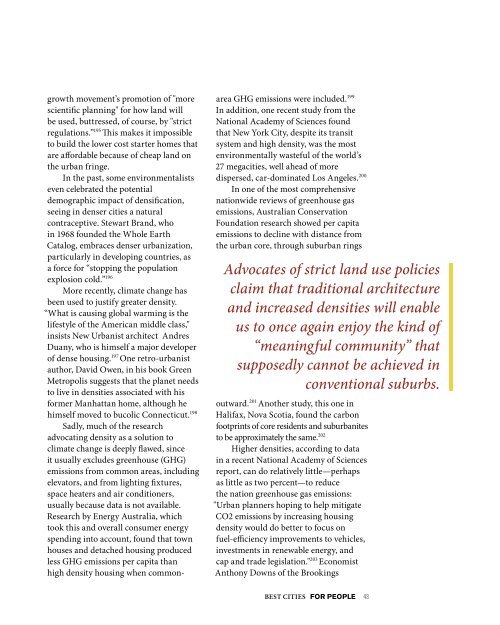FOR PEOPLE
1ONa2xt
1ONa2xt
Create successful ePaper yourself
Turn your PDF publications into a flip-book with our unique Google optimized e-Paper software.
growth movement’s promotion of "more<br />
scientific planning" for how land will<br />
be used, buttressed, of course, by "strict<br />
regulations.” 195 This makes it impossible<br />
to build the lower cost starter homes that<br />
are affordable because of cheap land on<br />
the urban fringe.<br />
In the past, some environmentalists<br />
even celebrated the potential<br />
demographic impact of densification,<br />
seeing in denser cities a natural<br />
contraceptive. Stewart Brand, who<br />
in 1968 founded the Whole Earth<br />
Catalog, embraces denser urbanization,<br />
particularly in developing countries, as<br />
a force for “stopping the population<br />
explosion cold.” 196<br />
More recently, climate change has<br />
been used to justify greater density.<br />
“What is causing global warming is the<br />
lifestyle of the American middle class,"<br />
insists New Urbanist architect Andres<br />
Duany, who is himself a major developer<br />
of dense housing. 197 One retro-urbanist<br />
author, David Owen, in his book Green<br />
Metropolis suggests that the planet needs<br />
to live in densities associated with his<br />
former Manhattan home, although he<br />
himself moved to bucolic Connecticut. 198<br />
Sadly, much of the research<br />
advocating density as a solution to<br />
climate change is deeply flawed, since<br />
it usually excludes greenhouse (GHG)<br />
emissions from common areas, including<br />
elevators, and from lighting fixtures,<br />
space heaters and air conditioners,<br />
usually because data is not available.<br />
Research by Energy Australia, which<br />
took this and overall consumer energy<br />
spending into account, found that town<br />
houses and detached housing produced<br />
less GHG emissions per capita than<br />
high density housing when commonarea<br />
GHG emissions were included. 199<br />
In addition, one recent study from the<br />
National Academy of Sciences found<br />
that New York City, despite its transit<br />
system and high density, was the most<br />
environmentally wasteful of the world’s<br />
27 megacities, well ahead of more<br />
dispersed, car-dominated Los Angeles. 200<br />
In one of the most comprehensive<br />
nationwide reviews of greenhouse gas<br />
emissions, Australian Conservation<br />
Foundation research showed per capita<br />
emissions to decline with distance from<br />
the urban core, through suburban rings<br />
Advocates of strict land use policies<br />
claim that traditional architecture<br />
and increased densities will enable<br />
us to once again enjoy the kind of<br />
“meaningful community” that<br />
supposedly cannot be achieved in<br />
conventional suburbs.<br />
outward. 201 Another study, this one in<br />
Halifax, Nova Scotia, found the carbon<br />
footprints of core residents and suburbanites<br />
to be approximately the same. 202<br />
Higher densities, according to data<br />
in a recent National Academy of Sciences<br />
report, can do relatively little—perhaps<br />
as little as two percent—to reduce<br />
the nation greenhouse gas emissions:<br />
"Urban planners hoping to help mitigate<br />
CO2 emissions by increasing housing<br />
density would do better to focus on<br />
fuel-efficiency improvements to vehicles,<br />
investments in renewable energy, and<br />
cap and trade legislation." 203 Economist<br />
Anthony Downs of the Brookings<br />
BEST CITIES <strong>FOR</strong> <strong>PEOPLE</strong> 43




